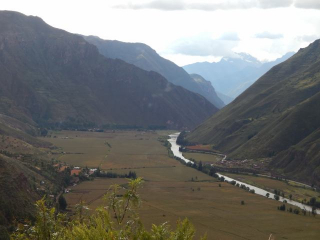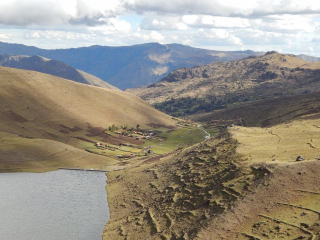As some of my regular readers know already, both my husband and I have been travelling the world and have found ourselves settling in the beautiful town of Pisac, Cusco in Peru, South America. Surrounded by mountains and the stunning Urubumba River, Pisac has been like a home to us and of course I have tested out my baking skills not thinking that the environment will somehow effect the way I bake.
Pisac is located 9,700 feet above sea level and believe me you can feel it. I felt it effect my body in various ways but I had no idea how it would affect my cooking and even more importantly, my baking. The weight of air is not something us bakers think about, however it can really affect the way your cakes rise. As elevation rises, the air pressure drops which means bakers living at 9,700 feet will see different results to the bakers living at sea level. Seeing as most recipes are designed for sea level, the bakers at high altitude will have to make a few minor adjustments if they want to receive success.
At high altitude and low air pressure, bakers will see two main effects on their baked goods;
1. The liquid evaporates more quickly at high altitude (hence water boils at a lower temperature than 100C).
2. Your cakes will rise much quicker in the oven and will lose moisture a lot faster, causing the cake to sink in the middle.
The science behind the ‘sinking cake’ is that as the cake begins to rise in the oven, the gaseous bubbles tend to get bigger and bigger forming large irregular pockets of air. This results in a harder, more course-textured cake. Additionally, the pressure can build within the cake causing the cell walls to stretch beyond their maximum capacity, causing them to burst and the centre of the cake to collapse. This is not a good look for a professional cake maker. The cake may still taste good, but without the soft, fluffy texture and the appearance, all you have is a baking tin full of tasty, baked slop.
Due to the altitude and the quick evaporation rate, this can make your cakes a lot more ‘sticky’ as the sugar can become more concentrated. The texture of your cake can even be effected as some cakes will not set and even when they do, they have lost all moisture and can become dry and crumbly.
For those of you out there looking for some help with baking at altitude, here are a few tweeks that you can make to your recipe to ensure that you will never make a dry, sticky, sunken, crumbly cake at altitude. Where ever you are in the world, test out these guidelines one at a time, to see which ones work for you and which ones do not:
– Add more ‘tenderisers’ these include; sugar and fats. These soften the cell walls and prevent the cells from over expanding, which in turn, prevents the cake from sinking in the middle.
– Add more ‘strengthener’ this is the flour, this will help with the structure of the cake.
– Reduce the amount of leavening agents, these include; Bicarbonate of soda and baking powder. This will reduce the pressure within the cell walls of the cake.
– Do not over beat the eggs as this can add too much air to the cake, the less air the better.
– Raising the temperature of the oven can also help with altitude baking as the high the temperature, will reduce the baking time and prevent the cake from rising too much (which usually leads to the cake falling).
1. Remove 1 to 3 tablespoons of sugar per cup. When baking from a normal non-adjusted recipe at high altitude, the surface of your cake can appear mottled in colour, this is because there is too much sugar in your recipe.
2. Remove (if required), 1 to 2 tablespoons of butter per cup.
3. Add an additional egg or egg white to your mixture. This adds more liquid to the mixture as well as some extra protein which helps the cake to set faster.
4. Some bakers add one extra tablespoon of flour to their mixture.
5. If you are baking a sponge cake, then removing half a teaspoon of baking powder is a good idea however, if you are making denser baked goods, then you may not need to adjust this.
6. There will be moisture loss within your cake so ensure to add liquid. Per cup of liquid, add 1 to 2 tablespoons, so if you are using milk, then add extra, this will allow for any loss of moisture.
7. Finally, check if the cake is ready early. By doing this, you can avoid any burnt cakes or disasters.
Hope this has helped!


Thank you so much for this!! Coming from coastal Australia I could not figure out why the cakes and brownies I had been making since I was tiny suddenly started sinking when I moved to the Japanese mountains. Tried a few of your tricks and I finally have a batch of brownies that look like they should!!